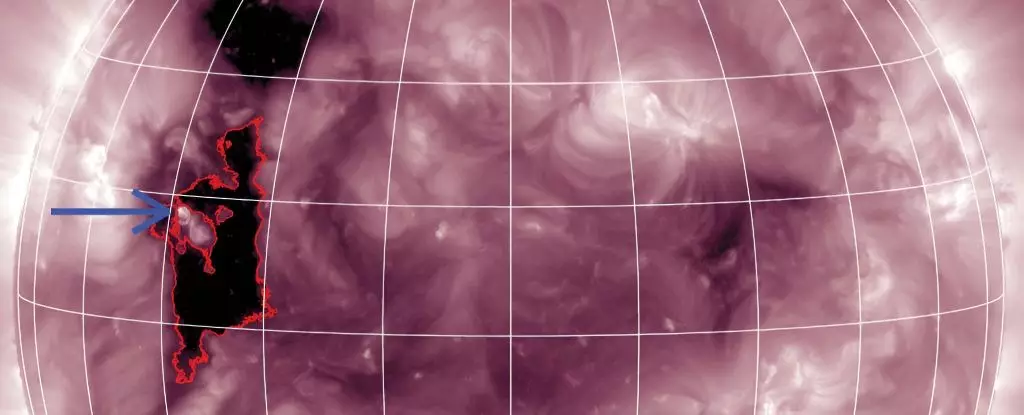In a groundbreaking revelation, a notable phenomenon has emerged from our Sun, capturing the attention of astronomers and astrophysicists alike. In late October 2023, an extraordinary solar eruption was observed, spewing out an unprecedented quantity of helium-3, a rare isotope. The intensity of this event marked it as the most significant release of helium-3 ever observed emanating from our central star, the Sun. This was not just mere cosmic fireworks; it was a tantalizing puzzle that hinted at deeper complexities within solar particle dynamics and elemental abundance in the universe.
Astronomers, propelled by curiosity and scientific rigor, traced the source of this helium-3 surge back to a coronal hole—a vast gap on the Sun’s surface where magnetic fields are more porous than usual. This atmospheric anomaly allowed particles to escape the Sun’s grip, resulting in a jet of plasma that was both profound and peculiar in its composition and behavior. Radoslav Bučík, an astrophysicist at the Southwest Research Institute, elaborated on this rarity, noting that helium-3 is typically found at a mere 0.002 percent in solar winds. However, during this event, concentrations soared to levels that were nearly unfathomable.
The Fascinating Role of Helium-3
Why does helium-3 command such attention in astrophysical discussions? Unlike the more prevalent helium-4, helium-3’s composition—with just one neutron less—marks it as an intriguing enigma in cosmic studies. Helium-4 comprises about 25% of the ordinary matter in the Universe, providing a stark contrast to helium-3’s scarcity, often referred to as the ‘unicorn’ of isotopes within hydrogen-rich regions. This rarity is compounded by various factors, including the conditions surrounding its production and the unique astrophysical processes that can selectively accelerate it into high-speed jets.
Observational data from the ESA and NASA’s Solar Orbiter during the significant dates revealed helium-3 being expelled at rates an astonishing 180,000 times above its normal concentration. Such findings challenge pre-existing assumptions about solar wind dynamics and open doors to reconsidering the role of solar jets in isotopic variance. They compel a reevaluation of our understanding of solar particle acceleration and the broader implications these have on nucleosynthesis theories post-Big Bang.
A Window into Solar Activity
This astronomical event further illustrates the intricate dance between solar activity and the materials output into the heliosphere—the region of space dominated by the Sun’s influence. The coronal hole, identified as the source of the ejecting plasma, released more than just helium-3; it also contained lower-than-expected concentrations of heavier elements such as iron, which usually dominate solar particle events. Instead, this event included a curious abundance of lighter elements like carbon, nitrogen, silicon, and sulfur. Plate tectonics operate on Earth, but in the plasma dynamics of the Sun, we are perhaps witnessing its own version of elemental flow—casting light on the evolutionary stages of elemental production in stars.
Bučík’s observations challenge the prevailing ideas about solar eruptions and the environmental conditions in which helium-3 enrichment might occur. His insights into the weak magnetic fields where these jets were formed suggest that turbulence and chaotic plasma interactions might not always be the enemies of elemental acceleration, as previously thought. The paradoxical nature of weak magnetic regions yielding such enriched particle flows begs further investigation and deciphers the rostro of our Sun’s unexplored mysteries.
The Implications of Rare Solar Events
The importance of these findings extends beyond immediate scientific curiosity. Understanding such solar particle events can enhance our knowledge about space weather, which poses significant threats to modern technologies such as satellites, communication networks, and even power grids on Earth. Events that can unleash a deluge of unusual isotopes carry vital information not only about our cosmic neighborhood but also about the underlying mechanics that govern stellar behavior.
Moreover, by situating Solar Orbiter approximately halfway between Earth and the Sun, scientists have leveraged its unique vantage point to gather critical data. It raises questions about the frequency of such phenomena. Are these solar jets, rich in helium-3 and lightweight elements, truly rare occurrences, or are they just under-observed due to their typical low-energy signatures?
The potential for discovery rises as we dive deeper into solar analytics, unearthing a tapestry of cosmic interactions that have shaped the universe’s elemental composition. Indeed, the rarity of these events could suggest a grander narrative about solar processes, waiting to be unraveled by future missions and advanced observational technologies. Thus, the journey into understanding our Sun—a celestial titan—continues, driven by curiosity and a quest for knowledge, revealing truths as vast and intricate as the universe itself.


Leave a Reply